Warships. Cruisers. British Empire style throwing
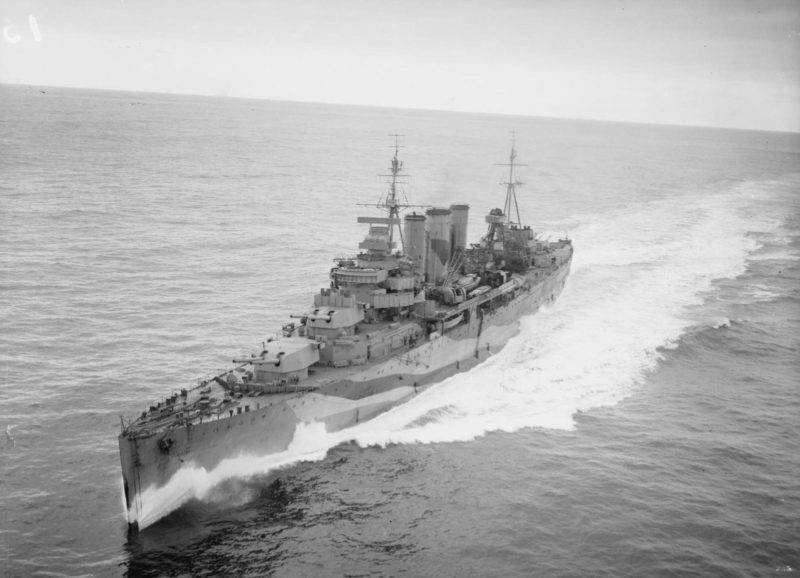
The bell of the naval agreement in Washington was also beaten by Britain. More precisely, according to the budget of the “Lady of the Seas”, it was no worse than the armor-piercing shells of German battleships and cruisers in the Battle of Jutland.
Having agreed with the rest of the participants, Britain began to build its heavy cruisers, and ... it became clear that this is a very expensive affair. The Hawkins turned out to be ships, to put it mildly, a little awkward, so the Admiralty quickly got rid of them and started story ships of the "County" type.
In general, these were three subtypes of ships, but the differences in designs were so minimal that they could be considered almost in bulk. And it turned out that all 13 heavy cruisers (type “Kent” - 7, type “London” - 4, type “Dorsetshire” - 2), although they were built, they cost so much that it became clear: for protection and protection trade communications of the colonies and the metropolis need something cheaper. Otherwise, the game will not be worth the candle.
So there were two "light heavy" cruisers such as the York, and then the British began to build at an accelerated socialist pace. flotilla light cruisers. In what, I must say, unlike the Germans, they were very successful, and at the beginning of World War II, Britain had 15 heavy and 49 light cruisers.
Solid, right? In general, the concept of the British fleet included 20 heavy and 70 light cruisers. This is for information.
We return to our heroes. “County” became a direct continuation of the Hawkins family, their tasks were about the same: search and trapping of enemy cruisers and admonishing them using the main caliber. And for auxiliary cruisers and other trifles there was an auxiliary caliber.
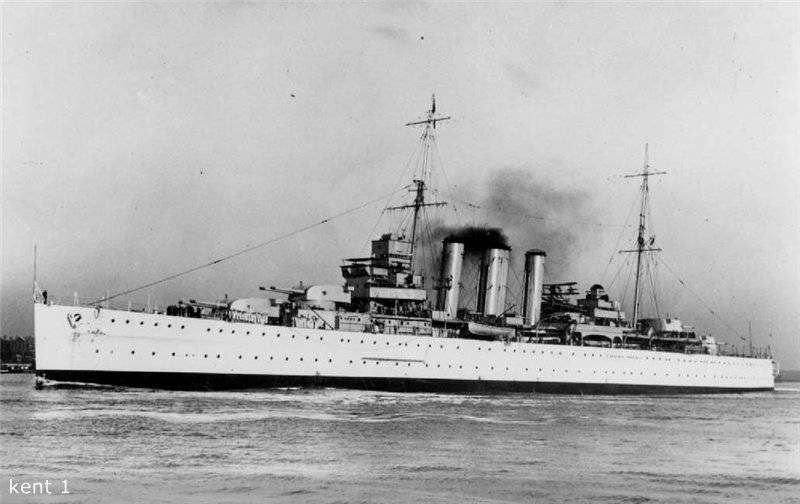
Naturally, raiding was not forbidden to British ships.
If you compare the “County” with contemporaries, you can see that in terms of speed, booking and air defense, these were not the best ships. But just a huge sailing range, powerful artillery weapons and excellent living conditions for the crews made these ships the best in the class precisely for solving such problems that were originally announced.
And if you do not pay attention to the rather old-fashioned look, which turned out thanks to three tall and thin chimneys and a very high side, then, in fact, the ships turned out to be what you need. Beautiful even.
And when it became clear that the seaworthiness is complete, it is not surprising that the main part of the service of these ships took place in the northern and polar waters, accompanied by Arctic convoys.
But at the time of the start of construction, being somewhat at a loss from the deed (all these maritime agreements and treaties), the British suddenly felt defenseless against a possible threat to their transport communications.
And after the commander of the Raleigh ditched the heavy cruiser entrusted to him on the stones, the number of sane heavy cruisers of the Hawkins type was reduced to four. And the light cruisers, remaining from the First World War, clearly did not meet modern requirements in terms of range and speed.
And the British rushed to build Washington cruisers.
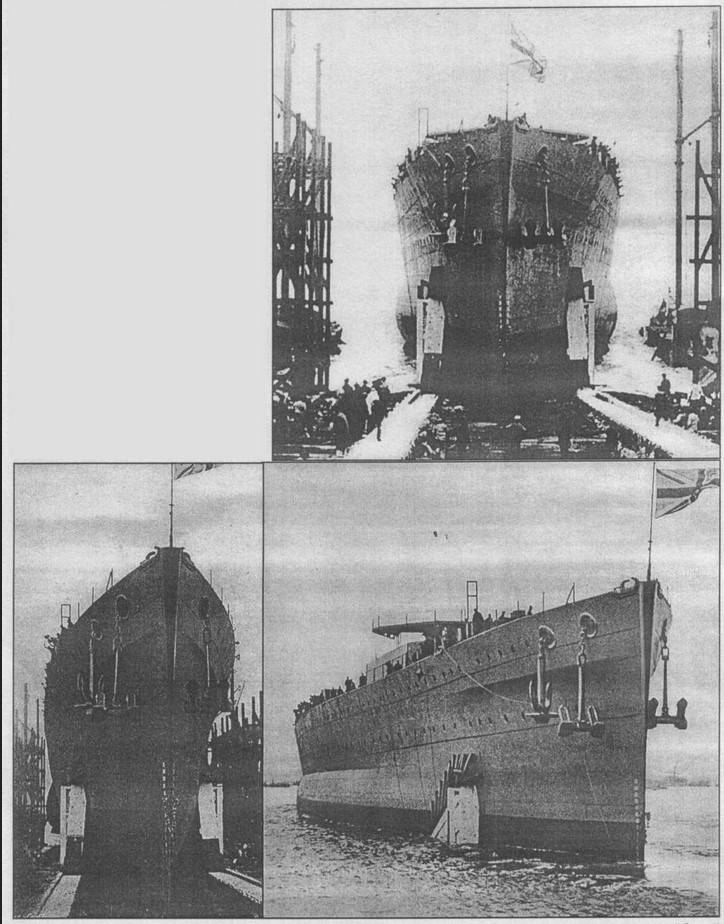
Naturally, these were supposed to be ships with a displacement of 10 tons, armed with 000 mm main guns, 203 mm anti-aircraft guns and 102 mm Vickers automatic cannons ("pom-pom").
The most debate was raised by the question of the number of guns in the towers of the Civil Code. One, two or three? Single-armed towers took up too much space, which prevented the deployment of a sufficient number of guns on ships, and it was difficult to use them all at once. It was well demonstrated by the operation of the Hawkins. Three-gun towers have not yet been completed structurally, because the golden mean was the placement of the main caliber in two-gun towers.
Thus, each cruiser had to carry eight 203-mm guns in four towers. In total, four projects were proposed for the trial of the Admiralty Commission, which differed from each other only in booking. There were boules designed to protect the ship from torpedoes and shells that fell below the waterline.
However, in reality, the reservation turned out to be insufficient. It was especially worth worrying about the sides in the area of engine rooms and boiler rooms, where the ship could easily penetrate even destroyer guns. Horizontal booking was not very good either, since armor over the same compartments and shell cellars did not protect them from shells of 203 and 152 mm calibers. There were doubts that the armor was able to withstand the hit of medium-caliber bombs (could not stand it).
Therefore, the project “D” was recognized as the winner, which had relatively good protection of the cellars, capable of withstanding the impact of a 140 mm caliber projectile falling at an angle of 203 ° from a distance of about 10 miles. Otherwise, the armor could be criticized in accordance with the points listed above. The total mass of the armor of the cruiser project "D" was 745 tons.
But project “D” was not accepted, but was sent under the designation “X” for the next competition, where other projects were presented. For example, one of the projects (“Y”) was supposed to remove one of the aft towers, leaving only six main-caliber guns, but to equip the ships aviation. That is, instead of a tower, mount a catapult and place at least two hydroplanes on board. At the same time, increase ammunition from 130 to 150 shells per gun.
In general, if you look, the “light heavy” “York” and “Exeter” were just made for this project.
The Admiralty did not like all three proposed projects. Still, one had insufficient reservation, the second did not have the proper firepower, so the project was developed for construction, which was developed by Sir Eustache Tennyson d'Eincourt, one of the creators of the Hood battlecruiser.
Sir Eustache, who was clearly thinking in ships, suggested a very original thing: leave almost everything as it is, but change the following parameters:
- increase the power of cars by 5 hp;
- extend the housing by 100 cm;
- narrow the body by 20 cm;
- reduce the ammunition of each gun by 20 shells.
A ship with such parameters definitely became faster by 1,5-2 knots. And the released weight could be sent to strengthen the armor.
And with the armor, Sir Estash also treated very progressively.
Sensibly judging that she still could not save from large-caliber shells, the thickness of the side armor in the area of the boiler rooms was reduced by half, making it 120-130 mm impermeable to shells.
But the horizontal armor above the boiler rooms and engine rooms (by 7 mm) and the vertical armor of artillery cellars (by 25 mm) were increased.
The estimated speed of the ships was estimated at 31,5 knots with a standard displacement and 30,5 knots with a full one.
In this form, all the relevant signatures were put on the project. The first ship of the series was called "Kent", according to it, as was customary, the whole type was also named. Naturally, these ships were considered heavy cruisers of the Washington class.
The Admiralty immediately expressed a desire to order at least 17 such cruisers. But the admirals had to be doused with cold water from the Thames, to be limited by budget.
So instead of 17 ships, five were ordered, and then the Australians came, who liked the ship, and ordered two more cruisers for themselves. Total - seven.
Kent, Berwick, Suffolk, Cornwall, Cumberland, Australia, and Canberra. The last two, of course, are Australian.
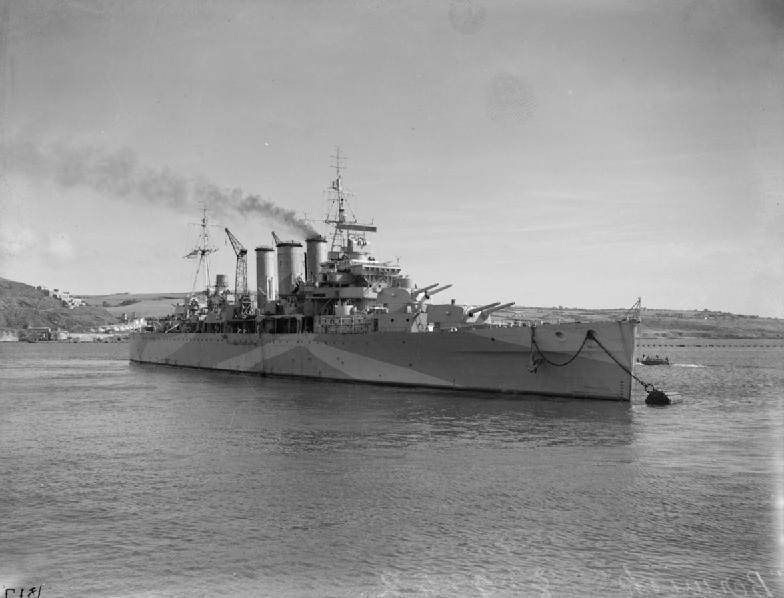
The new cruisers were smooth-deck high-breasted ships with three tall tubes and two masts. Their standard displacement turned out to vary in the range of 13425–13630 tons. Normally, as I have already said, everyone was chemical.
The ships had the following sizes:
- the greatest length: 192,02–192,47 m;
- length between perpendiculars: 179,79-179,83 m;
- width: 18,6 m;
- draft at standard displacement: 4,72-4,92 m;
- draft with full displacement: 6,47-6,55 m.
Initially, they wanted to install tripod masts on ships, but for reasons of weight saving, they were replaced with lighter masts.
“Kent” became the only cruiser of this type to receive a stern gallery, like the battleships of that time. The gallery slightly increased the length of the ship, but after a while it was dismantled altogether.
In peacetime, the crews of cruisers were 679-685 people., At the flagship - 710-716 people.
These cruisers, having excellent seaworthiness, enjoyed considerable popularity both among officers and sailors of the Royal Navy. Ships were considered “dry” and comfortable for the crew, having very spacious and well-arranged rooms.
But for the command, the seaworthiness of cruisers, which suddenly turned out to be very stable artillery platforms, became a big plus.
The armor remained not the strongest side. The final booking option for engine rooms, main caliber towers and ammunition cellars was as follows:
- armoring in the area of engine rooms - 25 mm;
- armored deck over engine rooms - 35 mm;
- armored deck over the steering device - 38 mm;
- armored bulkheads in the area of engine rooms - 25 mm;
- Side armor and roofs of the GK towers - 25 mm;
- armored floors of the towers GK - 19 mm;
- barbety GK towers - mm 25;
- traverse cellars of the towers "B" and "X" - 76 mm;
- lateral traverse cellars of the towers "B" and "X" - 111 mm;
- traverse cellars of towers "A" and "Y" - 25 mm;
- side traverses of the cellars of guns 102 mm - 86 mm.
In general, as you can see, so-so. Not for nothing that these cruisers were universally called "tin cans" or simply "tins."
The power plants of the cruisers were different. The ships had four steam turbines with a capacity of 80.000 liters. with. rotating four screws. Cornwall, Cumberland, Kent, and Suffolk received Parsons turbines, the rest from Brown-Curtis.
The turbines were fed with steam from eight crude oil boilers. The smoke from the first boiler room burning in oil boilers was diverted to the front and middle chimneys, and the second to the middle and rear.
The pipes had to endure many improvements. When the tests revealed that the smoke from the low pipes completely obscures the battery of 102-mm anti-aircraft guns and the aft fire control post, they decided to extend the pipes. First they threw a meter on the Cumberland when they were convinced that it didn’t help, it was decided to extend two front pipes to 4,6 m, and then all three. On Australian cruisers they were lengthened even more - up to 5,5 m.
During sea trials, the cruiser series showed very good results. On average, the maximum design speed of 31,5 knots at standard displacement and 30,5 knots at full turned out to be more by a whole knot.
Later, during operation, the maximum speed briefly reached 31,5 knots, constant - 30,9 knots.
The oil reserve (3425–3460 tons) made it possible to make transitions of 13–300 miles with an economic course of 13 knots. At a speed of 700 knots, the cruising range decreased to 12 miles, at full speed (14 knots) - 10 - 400 miles, at 30,9 knots - 3 miles.
For that time - an excellent indicator.
weaponry
The GK artillery consisted of eight 203-mm Vickers Mk VIII guns of the 1923 model, located in four two-gun Mk I towers with a hydraulic drive.
Due to the achievement of the maximum elevation angle of the guns of 70 ° (instead of the specified 45 °), the main caliber of the cruisers could conduct anti-aircraft fire. Conditionally, since normal anti-aircraft fire required a rate of fire. But she did not shine. 4 rounds per minute. Excellent for a normal naval battle and about nothing in terms of anti-aircraft barrage.
The cruisers' guns pierced 10 mm armor at a distance of 000 m, and 150 mm at a distance of 20 m. Ammunition for each gun in peacetime amounted to 000 shells, in war - from 80 to 100.
Not far from the midship was the main anti-aircraft artillery platform with four Vickers Mk V 102-mm guns on the Mk III.
The first pair of these guns was located on both sides of the third chimney, the second - a few meters further to the stern. The ammunition per gun was 200 shells. In 1933, a third pair of the same guns was additionally installed on both sides of the first chimney on the Kent cruiser.
The planned armament of the cruisers with eight-gun pom-pom anti-aircraft guns did not take place, so I had to do with the installation of four 40 mm Vickers Mk II anti-aircraft guns. They were also placed in pairs on both sides of the platforms between the first and second pipes. Their ammunition was 1000 shells per gun.
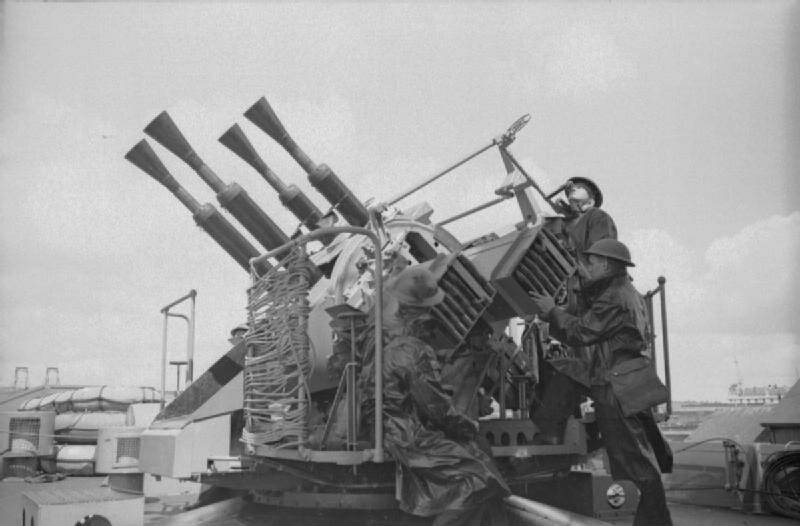
The cruisers' armament also included four 47-mm (3-pound) Hotchkiss Mk II L40 salute guns and 8-12 7,62-mm Lewis machine guns.
There was also a traditionally strong torpedo weapon for British ships. Eight 533-mm torpedo tubes in two four-pipe QRII rotary launchers, first used on such large ships, were located on the main deck on both sides under the main anti-aircraft artillery platform.
The armament consisted of torpedoes Mk.V, which at a speed of 25 knots had a range of 12 m and a warhead weight of 800 kg. For the Australian cruisers used more modern torpedoes Mk.VII, which at a speed of 227 knots had a range of 35 15 m and 300 kg of explosives.
The project provided equipment for reloading the TA, but in fact it was not installed on any of the cruisers. That is, the ammunition consisted of eight torpedoes.
Aviation
As a result, they shoved it all the same. And all the cruisers received an SIIL (Slider MkII Light) light swivel catapult, behind the third chimney.
The seaplanes were first Fairey "Flycatcher", and then they were replaced by Hawker "Osprey".
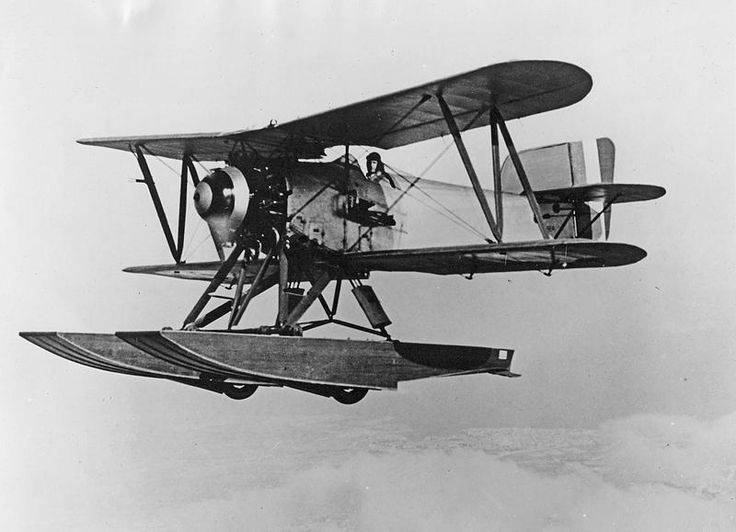
Cranes located on the starboard side were used to lift the aircraft from the water and mount it on the catapult.
Of course, throughout the entire service of ships, weapons underwent various modernizations. This was especially true of anti-aircraft weapons. By the beginning of World War II, nevertheless, the old Vickers automatic guns had been replaced by “gun-pumps” of eight barrels, placing them on platforms on either side of the first chimney.
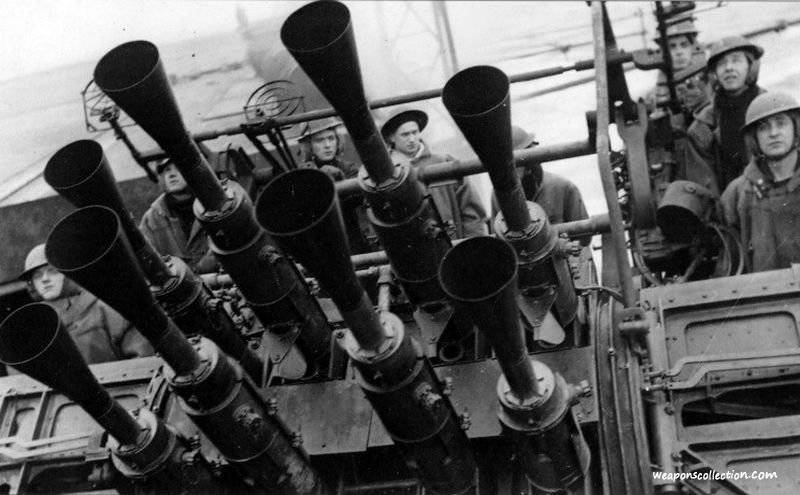
And on the roofs of the seaplane hangars, the 12,7 mm Vickers MkIII / MkI machine guns were registered.
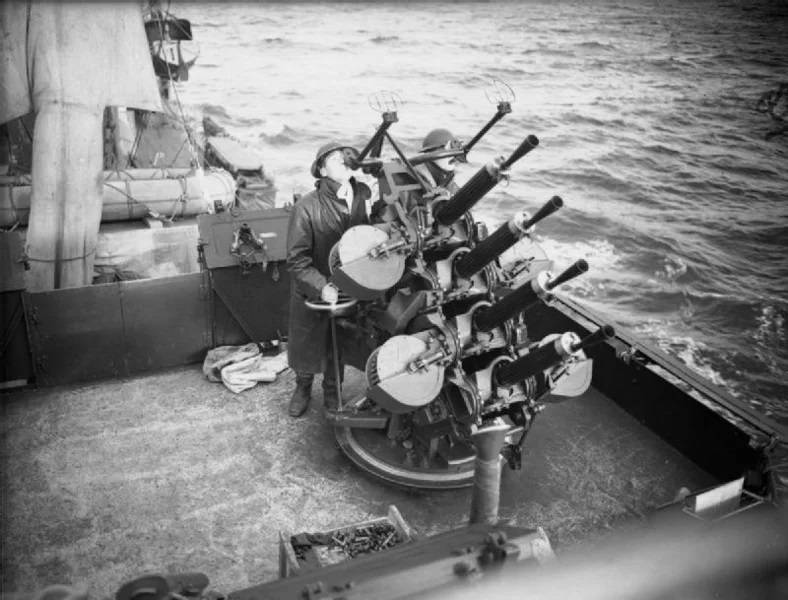
Over time, torpedo tubes were dismantled on all ships.
Vickers' large-caliber machine guns were removed in 1942-1943 (only Cornwall and Canberra preserved them), and back in 1941 the armament of cruisers with single-barrel 20-mm Oerlikon MkIV anti-aircraft guns was launched. Since 1943, the same anti-aircraft guns were installed, but in a twin version, and in 1945 the number of Erlikons on ships already reached 12-18.
True, in the realities of that war it was still not enough. And after the Japanese pilots effortlessly got rid of the Cornwall and Dorsetshire, the armament of the ships was anti-aircraft weapons small caliber was still found to be unsatisfactory. The British began to dismantle useless airborne weapons, while increasing the number of anti-aircraft barrels.
By mid-1943, only cranes remained on the “Kentes” of aviation equipment, which now served to lift boats and powerboats.
Radar
The first Kent type cruiser on which radar equipment was installed was the Suffolk. In early 1941, a Type 279 airborne detection radar was mounted on it, the antennas of which were mounted on the tops of the masts. This radar, operating in the 7-meter range and put into service in 1940, paid for itself during the battle in the Danish Strait. It was Suffolk with the help of radar that discovered the dribbling Bismarck and brought everyone else to it.
The idea "went", and the cruisers began to receive radars type 281, 273, 284 and 285.
The combat use of Kent-class cruisers is worthy of a separate article, because our heroes were noted wherever possible. And the Atlantic, and the polar waters, and, naturally, the Pacific Ocean.
Speaking about the success or not of the battle path of the cruisers, let's say this: not bad.
Suffolk was damaged by direct hit of a 1000-kg bomb 17.04.1940/10/XNUMX, repair - XNUMX months.
"Kent" 17.09.1940/XNUMX/XNUMX received a German airborne aboard, the repair lasted almost a year.
"Cornwall" was sunk by Japanese carrier-based aircraft south of Ceylon 5.04.1942/XNUMX/XNUMX. The crew could not do anything with the Japanese bombers, even plainly dodge bombs, of which nine were hit on the cruiser.
"Canberra" was simply crushed by shells of Japanese cruisers in a battle near Fr. Savo 9.08.1942/7/XNUMX, the cruiser tried to save, but he sank after XNUMX hours.
But we will repeat separately about the battle path of the British heavy cruisers of the "Family" family, it’s worth it.
Regarding the work under the Washington Accords, I would like to say this. We can say that the “Kents” were the very first pancake that often comes out lumpy.
British designers and admirals really wanted to shove everything into 10 tons of displacement. Alas, many broke their brains on this, and the British were no exception. Therefore, as a result of throwing and compromises, they turned out just such ships.
The British began to build heavy cruisers designed to protect ocean communications, because they really did not want to repeat the economic blockade of the First World War.
It turned out that speed, reservation, and subsequently armament were sacrificed to the cruising range and seaworthiness.
Indeed, the seaworthiness of the County was more than excellent. They exceeded their numerous Japanese and American counterparts in range, not to mention Italian and French ships designed for service in a Mediterranean puddle. And as a result, the convoy service was completely successful. But the "County" and were imprisoned under it.
But according to other indicators, the “Counties” were in many ways inferior to the Washington cruisers of other countries.
Their speed of 31,5 knots was standard for the British fleet, but noticeably inferior to the speed of the early Italian, French and Japanese cruisers, reaching 34,5 (French Tourville and Japanese Aoba) and even 35,5 knots (Japanese Myoko "And Italian" Trento ").
Armor is generally life for a ship. 25-mm armor of the sides and towers of cruisers made their way not only with 152-mm shells of light cruisers, but also with 120-127-mm shells of destroyers. Well, really not serious.
Frankly anti-aircraft weapons were "Kent". Anti-aircraft artillery, initially insufficient, was repeatedly changed and supplemented in the process of service and modernization, but the cruisers did not receive a sufficient number of barrels. This was confirmed by the Japanese, drowning virtually without loss (3 aircraft - this is a laugh) two heavy cruisers Dorsetshire and Cornwall.
On the whole, the idea of ocean defenders, capable of acting on maritime communications for a long time, was a success. The cruisers, capable of protecting and guarding convoys of transports and simply routes from enemy attacks, the British succeeded.
The sinking of the German Penguin raider by Cornwall is another confirmation of this.
But this turned out to be very highly specialized ships, and the British designers realized this very quickly. The subsequent subtypes of “County” became a kind of work on the bugs. How much this generally happened - we will analyze the next time.
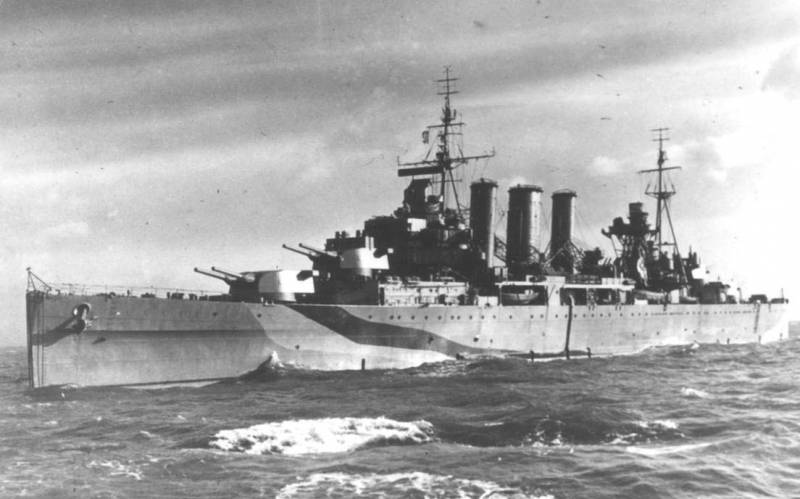
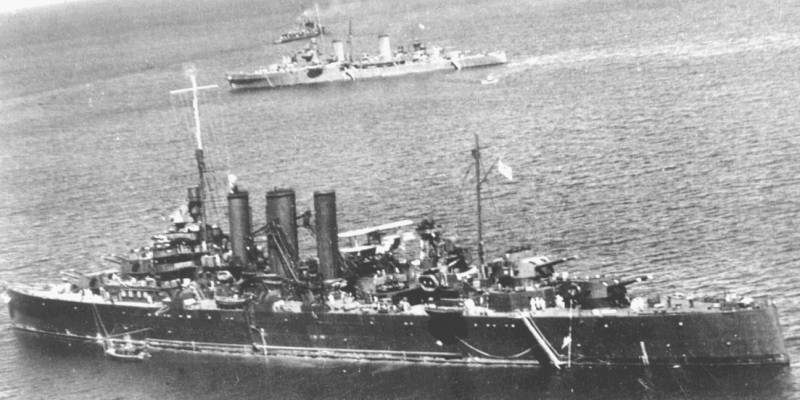
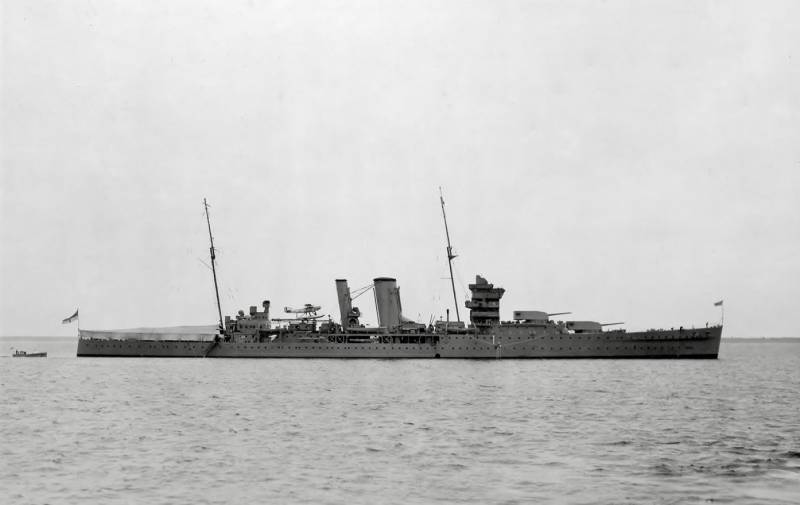
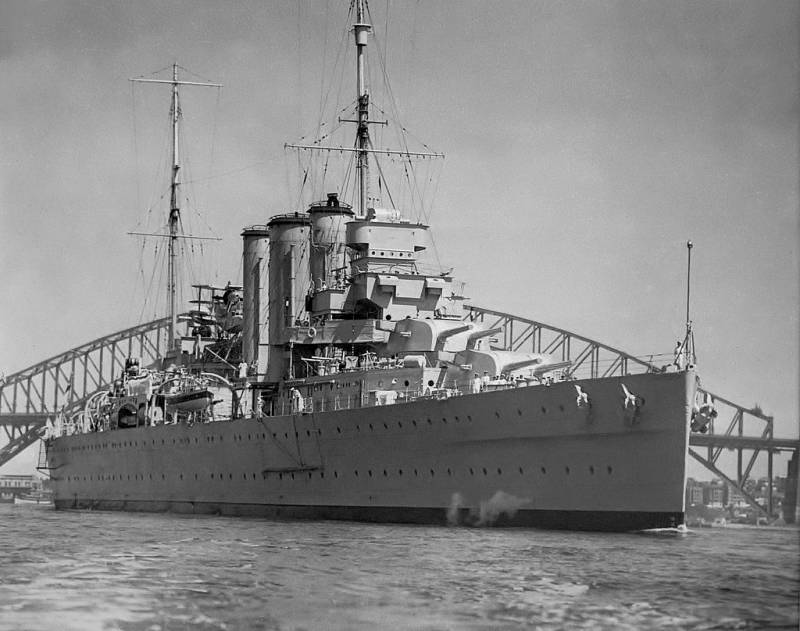
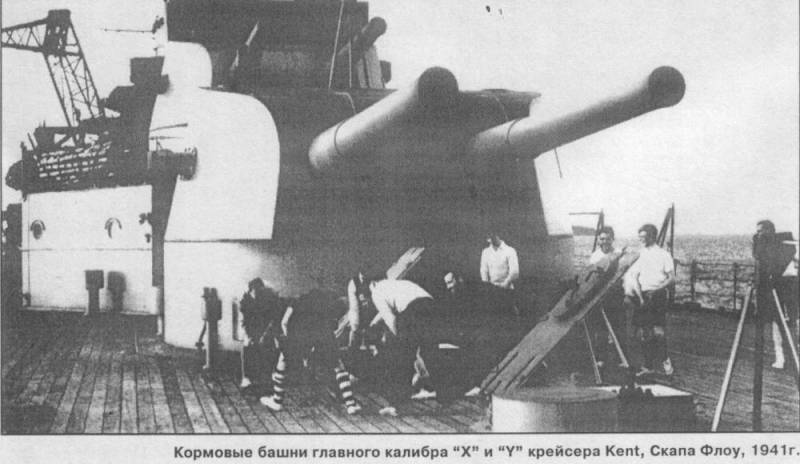
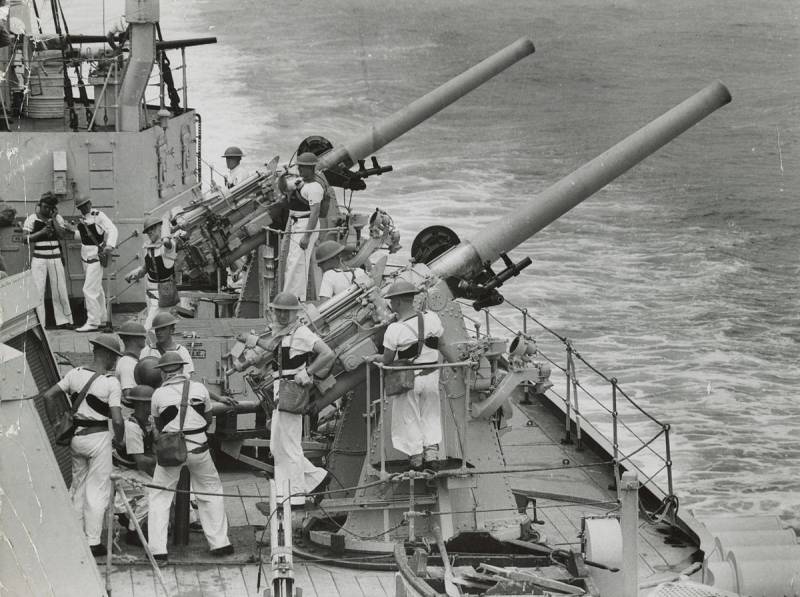
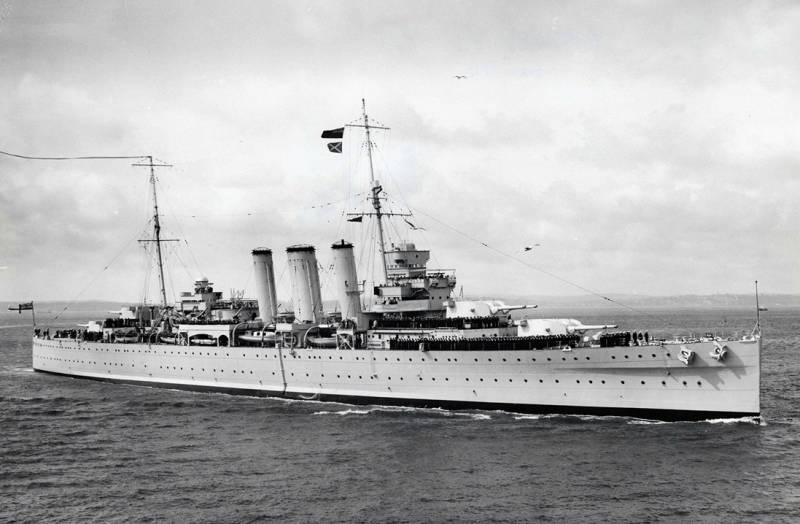
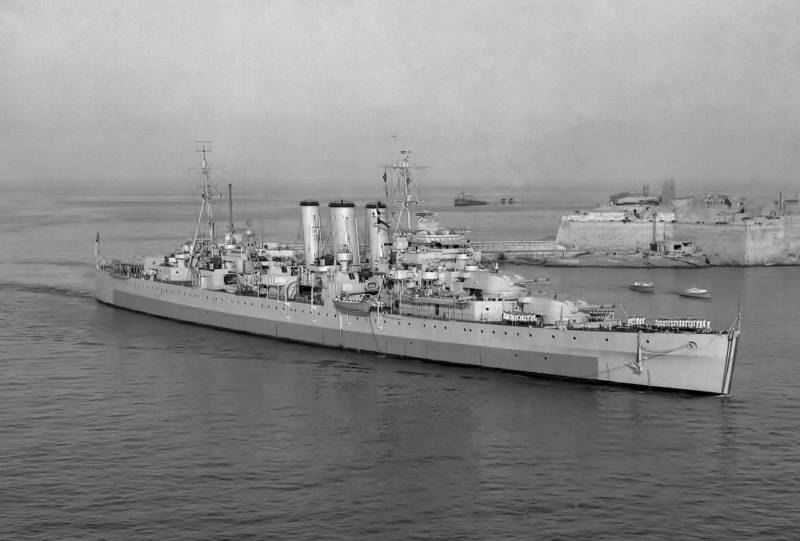
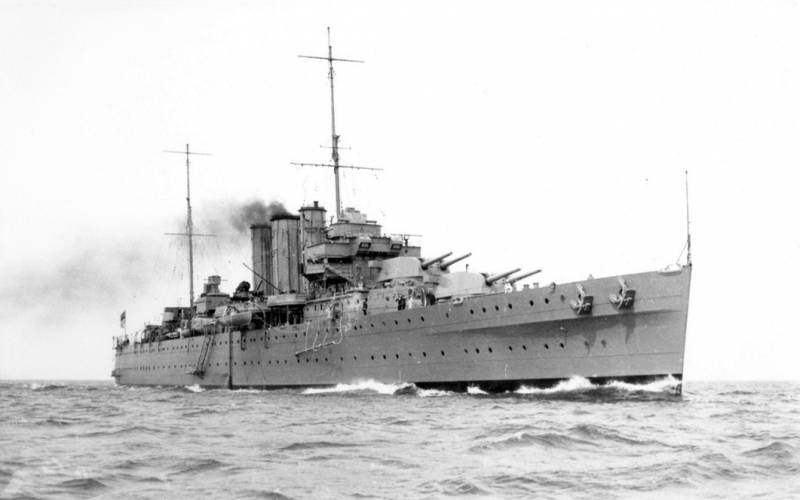
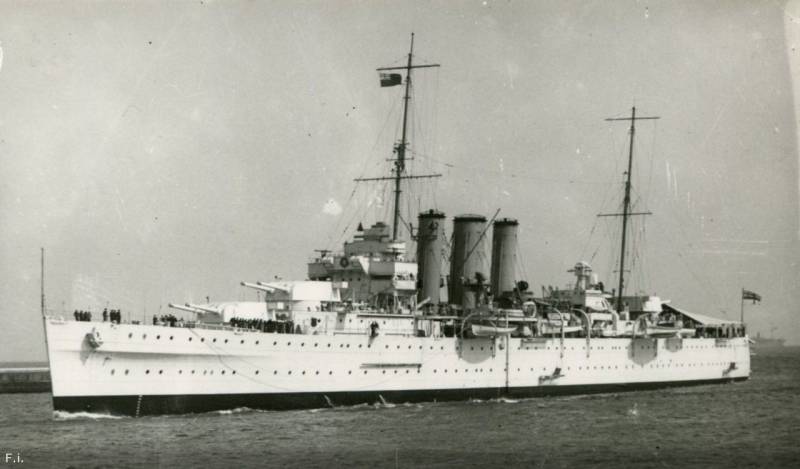
Information